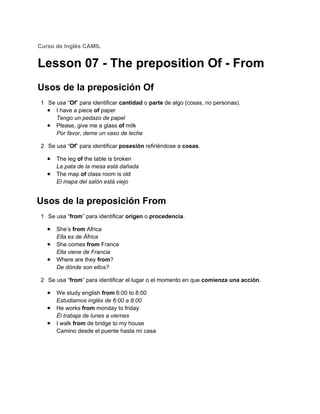
Lesson 07 the preposition of - from
- 1. Curso de Inglés CAMIL Lesson 07 - The preposition Of - From Usos de la preposición Of 1 Se usa “Of” para identificar cantidad o parte de algo (cosas, no personas). ● I have a piece of paper Tengo un pedazo de papel ● Please, give me a glass of milk Por favor, deme un vaso de leche 2 Se usa “Of” para identificar posesión refiriéndose a cosas. ● The leg of the table is broken La pata de la mesa está dañada ● The map of class room is old El mapa del salón está viejo Usos de la preposición From 1 Se usa “from” para identificar origen o procedencia. ● She’s from Africa Ella es de África ● She comes from France Ella viene de Francia ● Where are they from? De dónde son ellos? 2 Se usa “from” para identificar el lugar o el momento en que comienza una acción. ● We study english from 6:00 to 8:00 Estudiamos inglés de 6:00 a 8:00 ● He works from monday to friday Él trabaja de lunes a viernes ● I walk from de bridge to my house Camino desde el puente hasta mi casa
